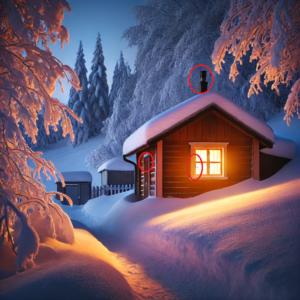Imagine waking up to the sound of rustling leaves instead of a blaring alarm system. You step onto your porch and see lush greenery around your yard, serving as both a beautiful landscape and a protective barrier. This kind of natural defense doesn’t just look nice—it can also discourage intruders, protect you from prying eyes, and even help shield against harsh weather. Relying on nature for home security might seem old-fashioned, but it’s practical and can be far more affordable than high-tech systems or heavy fencing.
You might be wondering how simple plants or earthen mounds can seriously contribute to security. It’s true that they won’t replace a good door lock or a mindful neighborhood watch. Still, they make an intruder’s approach more obvious, while giving you early warning or extra time to react. It’s a strategy that’s been used for centuries. Castles had moats and thick hedges. Rural homesteads planted thorny shrubs under windows. By working with the landscape, you turn nature into an ally that helps protect what matters most.
Natural barriers aren’t just for isolated farms or grand estates. Even if you live in a suburban lot or a semi-rural setting, you can adapt these ideas. Think about your budget, your property’s size, and the climate. Start with small changes, like strategically placed bushes or a row of climbing vines. Over time, you can expand into more elaborate features such as earthen berms or hedgerows. It’s all about blending security with a pleasing aesthetic. That way, you’re not just building a fortress—you’re also boosting curb appeal.
Why Natural Barriers Work
Nature has a way of making people slow down. A tall hedge filled with thorns discourages anyone who might think about taking a shortcut across your property. Dense shrubs force intruders to move carefully, often creating noise or leaving signs of disturbance. Even a simple row of lavender or low-lying bushes can create a mental barrier that says, “This place is cared for and watched.” When a space looks well-maintained, it signals that the occupants are alert, which can deter opportunistic threats.

You also gain privacy. Leafy plants block lines of sight, preventing prying eyes from pinpointing your activities. This can be crucial in times of unrest, when you don’t want strangers to know what supplies you have. Additionally, well-placed natural features can reduce wind speeds and deflect water flow away from vulnerable spots. That means less soil erosion near your foundation and fewer chances for weather damage.
Creating A Living Fence
One of the simplest ways to add a layer of security is by planting a living fence. Picture a row of thick shrubs or small trees grown close together. Thorny species, like certain varieties of roses or hawthorn, can turn what looks like a pretty boundary into a formidable obstacle. Anyone who attempts to push through a thick mass of thorns will think twice once they feel the prickle. It’s not foolproof, but it’s a hassle most trespassers won’t want to tackle.
If you have pets or small children, you might prefer shrubs without sharp thorns. In that case, you can choose dense evergreens, like arborvitae or cypress. They may not hurt someone climbing through them, but they create a visual and physical barrier that’s hard to bypass quietly. Wildlife also benefits, as living fences provide habitat for birds that might help with insect control. It’s a balanced approach: you get security, and local creatures find shelter and food.
Strategic Placement Of Plants
Anyone can plant bushes around the yard, but if you’re aiming for security, think carefully about placement. Look at potential entry points, like gates, windows, and doors. A thick cluster of plants under your first-floor windows stops someone from easily sneaking up. If you have a fence already, layering shrubs along its base makes climbing much harder. For property corners or boundaries near walkways, consider a row of tall grasses or hedges that obscure line of sight.

You can also create a winding path instead of a direct route to your front door. This forces a visitor to walk a certain path, which you can observe from your windows. If someone veers off, they’ll have to move through thick plants. That rustling could give you an early signal that someone is moving where they shouldn’t. This strategy doesn’t require a huge yard, just some clever planning to direct traffic or slow it down.
Earthen Berms And Raised Beds
If you have the space and resources, consider building small earthen berms around key parts of your property. A berm is basically a mound of soil, sometimes reinforced with rocks or sod, that creates a slope. It’s not just for show. Climbing a slippery slope of grass is far less appealing than walking on level ground. Plus, a raised berm can block headlights from passing cars if you live near a busy road. That means more privacy and fewer distractions at night.
Raised garden beds near your windows can also serve as mini-fortifications. They won’t stop a determined intruder forever, but they force someone to climb over obstacles. That extra step could cause enough noise or delay for you to notice their presence. Combine these beds with thick-rooted plants or thorny bushes, and you have a mild but real deterrent. Plus, you gain the benefits of homegrown vegetables or herbs. It’s a win-win for both sustenance and security.
Water Features As Deterrents
Water might not be the first thing you think of when it comes to security, but a strategically placed pond or narrow moat can shape how people approach your home. Of course, you might not have space or desire for a full-blown moat. Even a small pond or water-filled trench near a fence line can make crossing a challenge. The goal is to guide anyone on foot to a single point of entry, like a bridge or gate, where you can keep a closer eye.

You need to weigh the added maintenance. Water features require regular upkeep to avoid algae build-up, mosquitoes, or leaks. However, if you’re already interested in a koi pond or a natural pool for aesthetic reasons, consider how it might also serve a defensive purpose. A well-maintained pond can reflect light at night, revealing movement more clearly. And if your water feature is large enough, it can also provide a quiet vantage point for wildlife-watching when you’re not worrying about security.
Natural Camouflage And Vantage Points
In some cases, you might want to see out without letting others see in. A row of tall plants that partially obscure your windows from the outside could still allow you to see potential threats. Consider using partial screens of bamboo or tall ornamental grasses. You’ll have filtered views that maintain your privacy. If your property has a slight slope, placing a line of taller plants near the property boundary can create a higher vantage point inside your yard.

Think about an intruder’s line of sight. If you block it cleverly with curved landscaping or staggered plantings, anyone trying to scope out your home might be forced to get closer than they’re comfortable with. By the time they’re near enough to see clearly, you’ll likely have noticed them. This layered approach builds a sense of depth that’s both pleasing to the eye and functionally protective.
Maintenance Tips For Living Barriers
Plants offer a lot of benefits, but they do require upkeep. Neglected bushes become overgrown, which might create gaps or hide potential threats. Regular trimming ensures your plants remain dense at the right height. Removing dead branches keeps the area clean and reduces fire risk if you live in a region prone to wildfires. Watering, fertilizing, and pest control all matter if you want your green defenses to thrive.
Watch for signs of disease or insect infestation. A patch of dying shrubs can create a weak spot in your perimeter. If you spot issues early, you can treat or replace plants before the gap becomes noticeable. Some folks like to mix different plant varieties in one row. That way, if one species gets hit with a disease, the others might still remain healthy and maintain the barrier. Keeping that diversity also looks more natural and can attract beneficial insects or birds.
Combining Nature With Technology
Natural barriers excel at stopping casual trespassers, but you can reinforce them with modern tools. For example, place motion-sensor lights near thick bushes or tall hedges so they illuminate anyone moving through them at night. Install simple wireless cameras that blend into the foliage, giving you a hidden surveillance point. The combination of greenery and tech can catch an intruder off guard, since they might not realize they’re on camera until it’s too late.
Related: How to Use Everyday Objects for Self-Defense
Solar-powered lights along a hedge line can also reduce utility costs while deterring nighttime loiterers. If you’re concerned about your budget, look for basic models that store enough energy during the day for a few hours of illumination after sunset. When an unexpected figure moves close, the sudden light can startle them and alert you. That’s a small investment that can have a big impact on your overall security.
Final Thoughts
Relying on nature to protect your home doesn’t mean you dismiss locks, cameras, or other traditional measures. It means you enhance them. When you combine living fences, earthen berms, or water features with a mindful layout, you create a layered defense that’s both practical and beautiful. You also show that preparedness isn’t all about stockpiling gear. Sometimes, it’s about working with the land you already have.
Think about your property’s weak spots and ask how you can use plants or natural elements to fill those gaps. The answer might be as simple as a row of thorny shrubs under your windows or as elaborate as a well-placed pond. In each case, you’re letting the environment do some of the heavy lifting. That’s the kind of resourcefulness that keeps you confident, no matter what challenges come your way.






